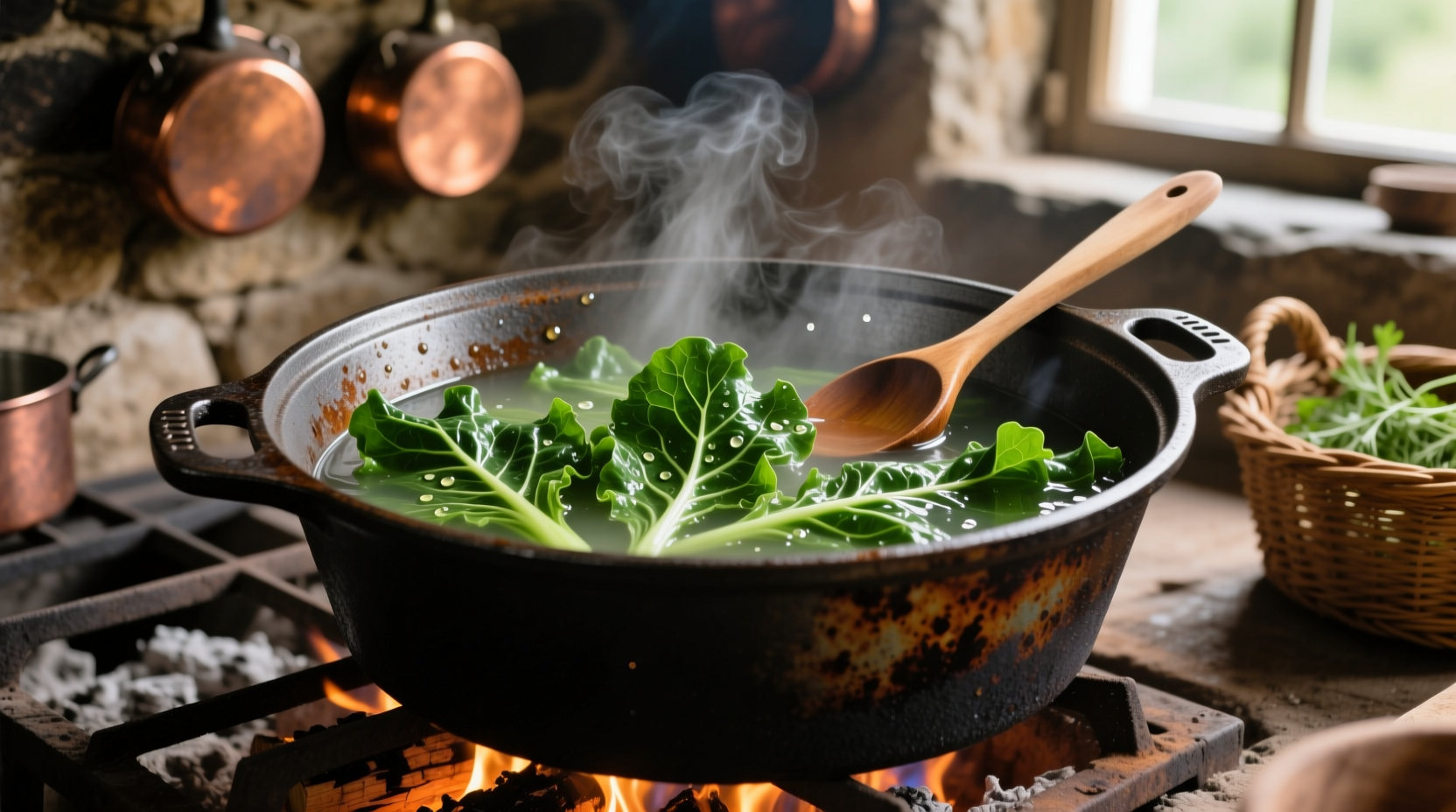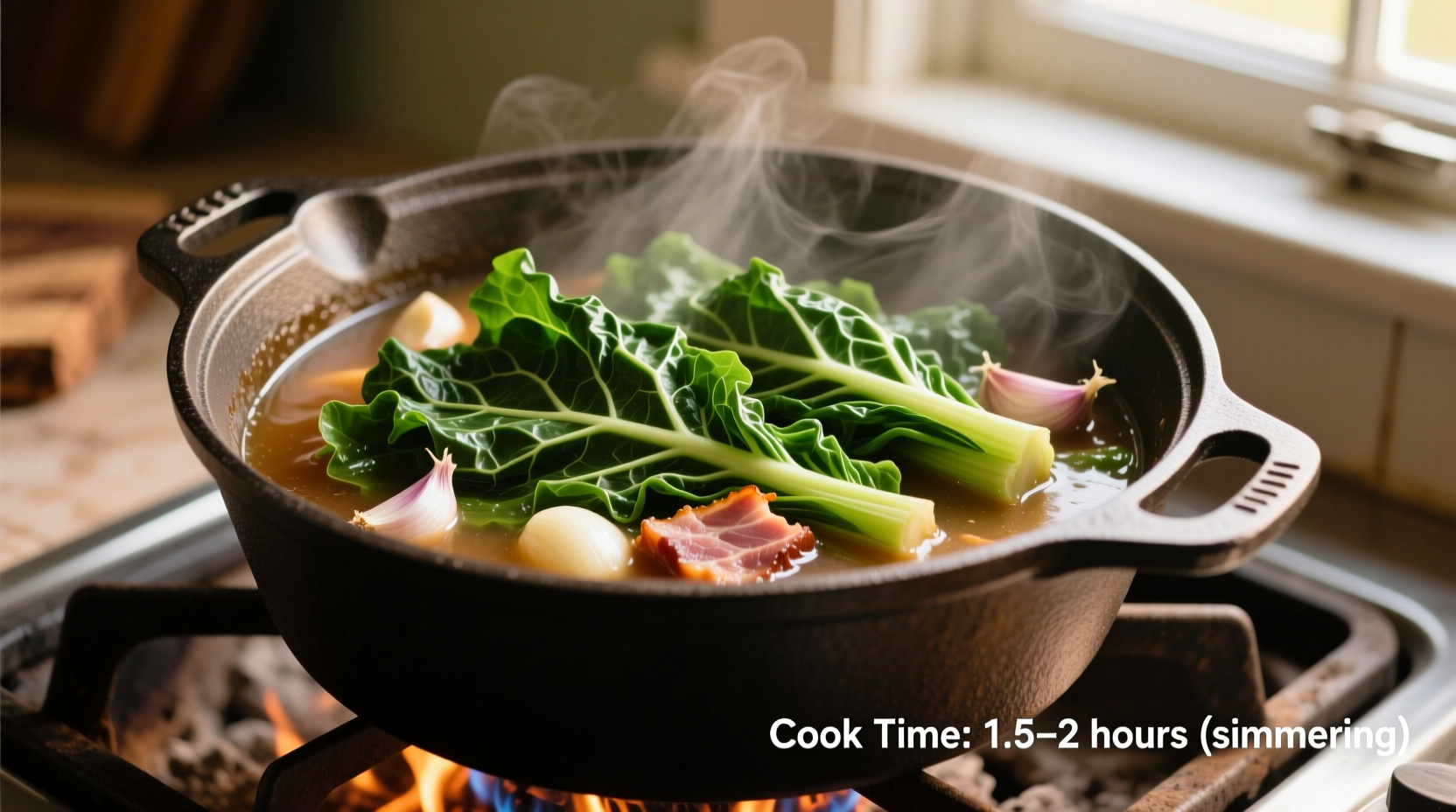Quick Reference: Collard Greens Cooking Time Chart
| Cooking Method | Prep Required | Minimum Time | Traditional Time | Texture Result |
|---|---|---|---|---|
| Boiling (traditional) | Washed, stems removed | 30 minutes | 45-60 minutes | Firm-tender |
| Pressure cooking | Washed, chopped | 8 minutes | 10-15 minutes | Tender |
| Sautéing | Washed, chopped | 5 minutes | 8-10 minutes | Crisp-tender |
| Slow cooking | Washed, stems removed | 4 hours | 6-8 hours | Melt-in-your-mouth |
Understanding Cooking Time Variables
While the standard answer for how long does it take collard greens to cook is 45-60 minutes for boiling, several factors dramatically affect this timeline. The USDA's Food Safety and Inspection Service confirms that proper cooking time ensures both food safety and optimal nutrient retention in leafy greens.
Collard greens contain tough cellulose fibers that require sufficient cooking time to break down. Unlike more delicate greens like spinach, collards need extended heat exposure to become palatable. Clemson Cooperative Extension notes that traditional Southern preparation often involves cooking times up to 2 hours for extremely tender results, particularly when using older, more mature leaves.

Step-by-Step Cooking Methods
Traditional Boiling Method (45-60 minutes)
- Wash thoroughly in cold water to remove grit
- Remove tough stems and center ribs
- Chop or tear leaves into bite-sized pieces
- Cover with cold water in a large pot (2-3 inches above greens)
- Add flavoring elements (onion, ham hock, or smoked turkey)
- Bring to a rolling boil, then reduce to simmer
- Cook uncovered for 45-60 minutes, stirring occasionally
- Season with vinegar or hot sauce during last 15 minutes
Pressure Cooking Shortcut (10-15 minutes)
Modern pressure cookers significantly reduce collard greens cooking time on stove. America's Test Kitchen research shows that 10 minutes at high pressure produces tender greens comparable to 45 minutes of traditional boiling. This method preserves more nutrients while achieving similar texture.
How to Tell When Collard Greens Are Done
Don't rely solely on the clock when determining how to know when collard greens are done. The perfect texture depends on personal preference and intended use:
- Firm-tender (30-40 minutes): Greens hold shape but bend easily; ideal for salads or quick side dishes
- Traditional tender (45-60 minutes): Leaves are soft but maintain some structure; perfect for Southern-style meals
- Melt-in-your-mouth (60+ minutes): Greens break apart with gentle pressure; preferred for traditional soul food preparation
Perform the pinch test: Take a leaf from the pot, let it cool slightly, then pinch between fingers. Properly cooked greens should yield easily without resistance. Overcooked greens become mushy and lose nutritional value, while undercooked greens remain unpleasantly tough.
Contextual Factors That Change Cooking Time
Several contextual elements affect how long to boil collard greens, creating important boundaries for your cooking process:
- Leaf maturity: Young spring collards cook faster (30-40 minutes) than mature winter greens (60+ minutes)
- Water pH: Adding baking soda (1/4 tsp) to cooking water reduces bitterness but shortens cooking time by 10-15 minutes
- Altitude: At elevations above 3,000 feet, add 5-10 minutes to standard cooking times
- Acidic ingredients: Vinegar or tomatoes added early increase cooking time by 15-20 minutes
Avoid These Common Mistakes
Many home cooks struggle with collard greens cooking time chart variations because they make these errors:
- Insufficient water: Greens must stay submerged; add more water if evaporating too quickly
- Overcrowding the pot: Cook in batches for even texture development
- Skipping the wash: Grit ruins texture and requires restarting the cooking process
- Adding salt too early: Wait until greens are partially cooked to prevent toughness
Storage and Reheating Guidelines
Properly stored cooked collards maintain quality for 3-5 days in the refrigerator. The National Center for Home Food Preservation recommends:
- Cool completely before storing in airtight containers
- Keep cooking liquid with greens to maintain moisture
- Reheat gently on stove (5-7 minutes) rather than microwave
- Flavor improves after 24 hours as flavors meld
Frequently Asked Questions
Can you cook collard greens too long?
Yes, overcooking collard greens beyond 90 minutes typically results in mushy texture and significant nutrient loss. While traditional recipes sometimes call for extended cooking, exceeding 2 hours usually degrades both texture and nutritional value. The ideal window for most preparations is 45-60 minutes.
Do collard greens get softer the longer they cook?
Generally yes, collard greens continue to soften with extended cooking as cellulose fibers break down. However, after approximately 90 minutes, further cooking yields diminishing returns in tenderness while increasing nutrient loss. The softening process follows a logarithmic curve - most texture change happens in the first 45 minutes.
Why do you put vinegar in collard greens?
Vinegar serves multiple purposes in collard greens preparation. It helps reduce bitterness, enhances color retention, and tenderizes the leaves by breaking down tough fibers. Southern culinary tradition typically adds vinegar during the last 15-20 minutes of cooking to balance flavors without significantly altering cooking time requirements.
How do you reduce cooking time for collard greens?
To significantly reduce how long does it take collard greens to cook, use a pressure cooker (10-15 minutes), chop greens very finely, or blanch leaves for 2 minutes before final cooking. Adding a pinch of baking soda to cooking water also reduces required time by 10-15 minutes by accelerating fiber breakdown.
Do collard greens need to be cooked?
While collard greens can be eaten raw in salads when very young and tender, most mature collards benefit from cooking to break down tough fibers. Raw collards have a bitter, grassy flavor and chewy texture that many find unpalatable. Cooking transforms their flavor profile and makes nutrients more bioavailable.











 浙公网安备
33010002000092号
浙公网安备
33010002000092号 浙B2-20120091-4
浙B2-20120091-4